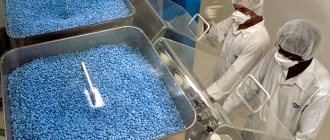Directions for use and doses
Inside.
Tablets should not be divided into parts. Leukeran is usually one of the components of combination therapy, and therefore, when choosing doses and administration of the drug, you should refer to special literature.
For adults.
Hodgkin's disease: as monotherapy, it is usually used at a dose of 0.2 mg/kg/day for 4–8 weeks.
Non-Hodgkin's lymphoma: as monotherapy, it is usually used initially at a dose of 0.1–0.2 mg/kg/day for 4–8 weeks, then maintenance therapy is carried out at a lower daily dose or in intermittent courses.
Chronic lymphocytic leukemia: the initial dose is 0.15 mg/kg/day (until the leukocyte count drops to 10·109/l), then it is possible to resume treatment after 4 weeks at a dose of 0.1 mg/kg/day.
Waldenström's macroglobulinemia. Leukeran is the drug of choice. The initial dose is 6-12 mg/day daily (until the onset of leukopenia), then it is recommended to switch to maintenance therapy - 2-8 mg/day daily for an indefinite period of time.
For children.
Leukeran is used to treat Hodgkin's disease and non-Hodgkin's lymphomas using the same regimens as in adults.
In case of lymphocytic infiltration of the bone marrow or in the case of bone marrow hypoplasia, the daily dose of Leukeran should not exceed 0.1 mg/kg body weight.
Release form, composition and packaging
Brown film-coated tablets, round, biconvex, engraved “L” on one side and “GX EG3” on the other.
One tablet contains:
active substance: chlorambucil – 2 mg;
excipients: anhydrous lactose, microcrystalline cellulose, anhydrous colloidal silicon, stearic acid;
shell composition: Opadry brown YS-1-16655A (hypromellose, titanium dioxide, macrogol, iron oxide yellow, iron oxide red).
25 pcs. - dark glass bottles (1) - cardboard packs.
Precautionary measures
It is prescribed under the control of blood tests, kidney and liver function. For bone marrow hypoplasia, the daily dose should not exceed 0.1 mg/kg. Treatment of chronic lymphocytic leukemia in patients with signs of bone marrow failure should begin with prednisolone. Leukeran therapy should not be stopped if the number of neutrophils decreases, but it should be taken into account that it can continue for 10 days after discontinuation of treatment. In patients with severe liver dysfunction, dose reduction is recommended. Patients with reduced renal excretory function should be under strict supervision, because they may develop additional myelodepression associated with azotemia.
Contraindications
- pregnancy;
- period of breastfeeding;
- hypersensitivity to any component of this drug.
With caution (it is necessary to compare the risk and benefit) - suppression of bone marrow function (severe leukopenia, thrombocytopenia and anemia); chicken pox (current or recent), herpes zoster, acute infectious diseases of a viral, fungal and bacterial nature, bone marrow infiltration by tumor cells, gout (history), urate nephrourolithiasis, head trauma (history), epilepsy (history ), severe liver and kidney diseases.
Synonyms of nosological groups
Category ICD-10 Synonyms of diseases according to ICD-10
| C50 Malignant neoplasms of the breast | Hormone-dependent form of recurrent breast cancer in menopausal women |
| Hormone-dependent breast cancer | |
| Disseminated breast carcinoma | |
| Disseminated breast cancer | |
| Disseminated breast cancer with HER2 overexpression | |
| Malignant breast tumor | |
| Malignant neoplasm of the breast | |
| Breast carcinoma | |
| Contralateral breast cancer | |
| Locally advanced or metastatic breast cancer | |
| Locally advanced breast cancer | |
| Locally recurrent breast cancer | |
| Metastatic breast carcinoma | |
| Metastases of breast tumors | |
| Metastatic breast carcinoma | |
| Inoperable breast carcinoma | |
| Inoperable breast cancer | |
| Breast tumors | |
| Breast cancer in women with metastases | |
| Breast cancer in men with metastases | |
| Breast cancer | |
| Breast cancer in men | |
| Mammary cancer | |
| Breast cancer with distant metastases | |
| Postmenopausal breast cancer | |
| Breast cancer is hormone dependent | |
| Breast cancer with local metastases | |
| Breast cancer with metastases | |
| Breast cancer with regional metastases | |
| Breast cancer with metastases | |
| Nipple and areola cancer | |
| Common hormone-dependent forms of breast cancer | |
| Advanced breast cancer | |
| Recurrent breast cancer | |
| Recurrence of breast tumors | |
| RMJ | |
| Estrogen-dependent breast cancer | |
| Estrogen-dependent breast cancer | |
| C56 Malignant neoplasm of the ovary | Ovarian adenocarcinoma pseudomucinous |
| Germ cell tumor of the ovary | |
| Germ cell tumor of the ovaries | |
| Malignant ovarian tumor | |
| Mucinous ovarian carcinoma | |
| Ovarian carcinoma | |
| Metastatic malignant tumor of the ovaries | |
| Metastatic ovarian carcinoma | |
| Metastatic ovarian cancer | |
| Metastatic ovarian cancer | |
| Ovarian tumor | |
| Cancer from pseudomucinous cyst | |
| Ovarian cancer | |
| Ovarian cancer | |
| Advanced metastatic ovarian cancer | |
| Advanced ovarian cancer | |
| Trophoblastic tumors | |
| Chorionic carcinoma | |
| Cystadenocarcinoma of the ovary, mucinous | |
| Ovarian cystocarcinoma pseudomucinous | |
| Epithelial tumor of the ovaries | |
| C81 Hodgkin's disease [lymphogranulomatosis] | Hodgkin's disease |
| Generalized form of Hodgkin's disease | |
| Lymphogranulomatosis | |
| Hodgkin's lymphoma | |
| Lymphoproliferative diseases | |
| Paltauf-Sternberg disease | |
| Pel-Ebstein fever | |
| Fibromyeloid reticulosis | |
| Hodgkin's malignant lymphoma | |
| Hodgkin's lymphoma | |
| C83 Diffuse non-Hodgkin's lymphoma | Diffuse large B-cell non-Hodgkin lymphoma |
| Malignant lymphoma | |
| Malignant lymphoma, especially histiocytic type | |
| Lymphoblastic non-Hodgkin's lymphoma | |
| Non-Hodgkin's lymphoma, diffuse | |
| Liver lymphoma | |
| Hepatic lymphoma | |
| Lymphoma recurrence | |
| Recurrent non-Hodgkin's lymphoma | |
| C88.0 Waldenström's macroglobulinemia | Waldenström's disease |
| Macroglobulinemic lymphoma | |
| Macroglobulinemia | |
| C91 Lymphoid leukemia [lymphocytic leukemia] | Lymphocytic leukemia |
| Lymphoproliferative diseases | |
| Lymphoproliferative disorders | |
| Neuroleukemia | |
| Refractory acute lymphoblastic leukemia | |
| Refractory lymphoblastic leukemia | |
| Transformation of preleukemia | |
| Chronic lymphocytic leukemia |
Drug interactions
When used simultaneously with drugs that inhibit hematopoiesis, increased myelotoxicity is possible.
When used simultaneously with anti-gout drugs, dose adjustment of the latter is required (chlorambucil may increase the concentration of uric acid in the blood).
Tricyclic anti-depressants, as well as haloperidol, maprotiline, monoamine oxidase inhibitors, phenothiazines, thioxanthenes can lower the threshold for seizure activity and increase the risk of seizures.
Drugs that intensively bind to plasma proteins increase the toxicity of chlorambucil (competition at the level of protein binding).
With inactivated viral vaccines - a decrease in the production of antibodies in response to the vaccine; with live viral vaccines - intensification of the replication process of the vaccine virus, increasing its side/adverse effects and/or reducing the production of antibodies.
For impaired renal function
Use with caution (risks and benefits must be weighed) in severe kidney disease. Patients with impaired renal excretory function should be closely monitored, because they may develop more severe myelosuppression associated with azotemia.
When the concentration of uric acid in the blood serum increases, the use of urine alkalizing agents is recommended. The development of nephropathy can be prevented by adequate fluid intake or by administering allopurinol as needed.
For liver dysfunction
Use with caution (risks and benefits must be weighed) in severe liver diseases. Patients with severe liver dysfunction should be prescribed lower doses.
special instructions
Leukeran is a cytotoxic agent that should only be used under the supervision of a physician experienced in the use of such drugs.
When the outer shell is intact, contact of Leukeran tablets with the skin is harmless. Splitting tablets is prohibited. When using Leukeran tablets, you should follow the recommendations for the use of cytotoxic drugs.
Since Leukeran can cause irreversible depression of bone marrow function, during treatment it is necessary to systematically (at least 2-3 times a week) perform a complete blood count with counting of peripheral blood cells.
When used in therapeutic doses, Leukeran inhibits the production of lymphocytes and, to a lesser extent, affects the number of neutrophils and platelets, as well as the level of hemoglobin.
There is no need to stop taking Leukeran at the first sign of a decrease in neutrophil counts, but be aware that the decrease in neutrophil counts may continue for 10 days or more after the last dose.
Since the use of alkylating agents is associated with a significant increase in the incidence of acute leukemia, when prescribing chlorambucil, it is necessary to weigh the risk of acute leukemia against the potential therapeutic effect of this drug.
For patients previously treated with cytotoxic drugs or undergoing radiation therapy, Leukeran is prescribed no earlier than 1.5-2 months after the end of previous treatment, provided there is no severe leukopenia, thrombocytopenia and anemia.
Children with nephritic syndrome, patients receiving high-dose pulse therapy with Leukeran, and patients with a history of seizures should be closely monitored by a physician during the course of treatment with Leukeran, as they may be at increased risk of developing seizures.
Side effects
From the hematopoietic system: leukopenia (reversible if the drug is stopped in a timely manner), thrombocytopenia, lymphopenia, neutropenia, decreased hemoglobin content, irreversible depression of bone marrow function.
From the gastrointestinal tract: nausea, vomiting, diarrhea, ulceration of the oral mucosa, hepatotoxic effect of toxic-allergic origin (hepatonecrosis or cirrhosis, cholestasis, jaundice).
From the respiratory system: interstitial fibrosis of the lungs (with long-term use of chlorambucil), interstitial pneumonia.
Allergic reactions: skin rash, urticaria-like rash, angioedema; extremely rarely - exudative erythema multiforme (Stevens-Johnson syndrome), toxic epidermal necrolysis (Lyell's syndrome).
From the nervous system: convulsions in children with nephrotic syndrome; rarely - local and/or generalized convulsions in children and adults receiving chlorambucil in therapeutic doses daily or courses of high-dose pulse therapy; extremely rarely - uncertainty when walking, tremors, muscle twitching, peripheral neuropathy, paresis, agitation, confusion, severe weakness, anxiety, hallucinations.
From the urinary system: aseptic cystitis.
Other: drug-induced hyperthermia, hyperuricemia or nephropathy caused by increased formation of uric acid (the result of rapid cell breakdown), menstrual irregularities, secondary amenorrhea, azoospermia, secondary malignancy.

